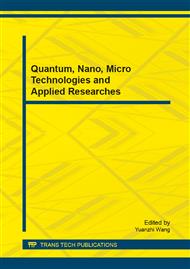[1]
S. Lai: Tech. Dig. IEDM (2003), p.255.
Google Scholar
[2]
Y. Yin, D. Niida, K. Ota, H. Sone and S. Hosaka: Rev. Sci. Instrum. Vol. 78 (2007), p.126101.
Google Scholar
[3]
H. Y. Cheng, Y. C. Chen, R. J. Chung and T. S Chin: Semicond. Sci. Technol. Vol. 21 (2006), p.1196.
Google Scholar
[4]
Y. Yin, T. Noguchi and S. Hosaka: Jpn. J. Appl. Phys. Vol. 50 (2011), p.105201.
Google Scholar
[5]
A. Pirovano, A. L. Lacaita, A. Benvenuti, F. Pellizzer and R. Bez: IEEE Trans. Electron Devices Vol. 51 (2004), p.452.
DOI: 10.1109/ted.2003.823243
Google Scholar
[6]
G. Bruns, P. Merkelbach, C. Schlockermann, M. Salinga, M. Wuttig, T. D. Happ, J. B. Philipp and M. Kun: Appl. Phys. Lett. Vol. 95 (2009), p.043108.
DOI: 10.1063/1.3191670
Google Scholar
[7]
Y. Yin, H. Sone and S. Hosaka: Microelectron. Eng. Vol. 84 (2007), p.2901.
Google Scholar
[8]
Y. Yin and S. Hosaka, Appl. Phys. Lett. Vol. 100 (2012), p.253503.
Google Scholar
[9]
D. H. Kang, D. H. Ahn, K. B. Kim, J. F. Webb and K. W. Yi: J. Appl. Phys. Vol. 94 (2003), p.3536.
Google Scholar
[10]
Y. Yin, H. Sone and S. Hosaka: Jpn. J. Appl. Phys. Vol. 51 (2012), p.104202.
Google Scholar
[11]
Y. H. Ha, J. H. Yi, H. Horii, J. H. Park, S. H. Joo, S. O. Park, U. I. Chung, J. T. Moon: Symp. VLSI Tech. Dig. Tech. Pap. (2003), p.175.
Google Scholar
[12]
J. Shen, B. Liu, Z. Song, C. Xu, F. Rao, S. Liang, S. Feng and B. Chen: Applied Physics Express Vol. 1 (2008), p.011201.
Google Scholar
[13]
Y. Yin, H. Sone and S. Hosaka: Jpn. J. Appl. Phys. Vol. 44 (2005), p.6208.
Google Scholar
[14]
T. H. Jeong, M. R. Kim, H. Seo, J. W. Park and C. Yeon: Jpn. J. Appl. Phys. Vol. 39 (2000), p.2775.
Google Scholar
[15]
S. M. Kim, J. H. Jun, D. J. Choi, S. K. Hong and Y. J. Park: Jpn. J. Appl. Phys. Vol. 44 (2005), p. L208.
Google Scholar
[16]
Y. Matsubara, J. Taniguchi and I. Miyamoto: Jpn. J. Appl. Phys. Vol. 45 (2006), p.5538.
Google Scholar
[17]
K. Liu, P. Avouris, J. Bucchignano, R. Martel, S. Sun, and J. Michl: Appl. Phys. Lett. Vol. 80 (2002), p.865.
DOI: 10.1063/1.1436275
Google Scholar
[18]
S. Hosaka, Z. Mohamad, M. Shirai, H. Sano, Y. Yin, A. Miyachi, and H. Sone: Appl. Phys. Express, Vol. 1 (2008), p.027003.
Google Scholar
[19]
T. Komori, H. Zhang, T. Akahane, Z. Mohamad, Y. Yin, and S. Hosaka: Jpn. J. Appl. Phys., Vol. 51 (2012), p. 06FB02.
Google Scholar
[20]
A.A.G. Driskill-Smith, J.A. Katine, D.P. Druist, K.Y. Lee, R.C. Tiberio, A. Chiu: Microelectron. Eng. Vol. 73–74 (2004), p.547.
Google Scholar


